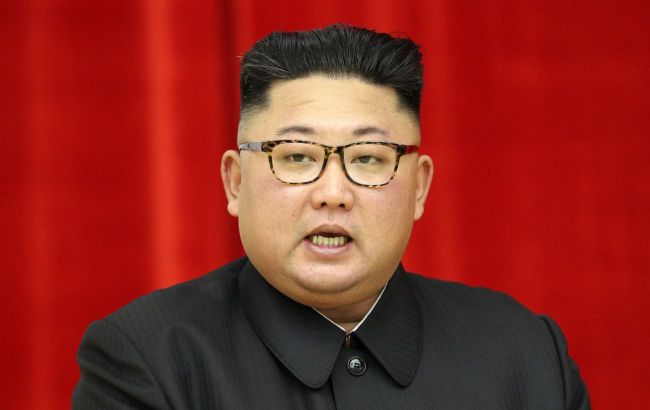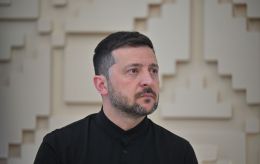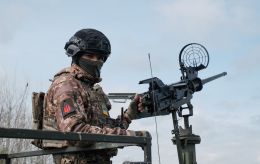Secrets of Kim Jong Un: Life under veil of dictatorship in North Korea and unresolved dispute between two Koreas
 Photo: North Korean leader Kim Jong Un (Getty Images)
Photo: North Korean leader Kim Jong Un (Getty Images)
North Korean leader Kim Jong Un is assisting Russian President Vladimir Putin in waging war against Ukraine and increasingly threatening nuclear weapons against the United States and South Korea. Despite the limited information available about him, his life is shrouded in secrecy, and rumors about his health have repeatedly raised questions about potential successors.
RBC-Ukraine provides insight into who Kim Jong Un is, how he became the North Korean dictator and his role in the contemporary geopolitical landscape.
In preparing this material, publications from BBC, The New York Times, The Japan Times, The Wall Street Journal, and The Business Insider were used.
Family, early years, and Swiss trace
Many details about Kim Jong Un's early years are shrouded in mystery. However, interesting details are provided in the book The Great Successor by New Zealand author Anna Fifield. The first mystery revolves around his birth date.
It is believed that Kim Jong Un was born on January 8, 1982, though it is not ruled out that he might be a year or two younger. For instance, in Japan, there is speculation that the year might have been altered, possibly tied to the 70th birthday of Kim Il Sung or the 40th birthday of Kim Jong Il—his grandfather and father, respectively.
When the U.S. Department of the Treasury imposed sanctions against Kim Jong Un, it mentioned a different date - January 8, 1984.
Kim Il Sung ruled from 1948 to 1994, and Kim Jong Il from 1994 to 2011. The latter had at least four different partners. One of them was Ko Yong Hui, the mother of the future dictator Kim Jong Un (a ballet dancer or opera singer), born in Japan and later moved to North Korea in the 1960s.
Ko Yong Hui was considered Kim Jong Il's favorite wife, adoring her son and calling him the King of the Morning Star. This nickname, alongside less flattering ones, is still used by the Western press.

Young Kim Jong Un in 2010 (screenshot from a video)
Kim Jong Un has two siblings, including older brother Kim Jong Chol (born in 1981) and younger sister Kim Yo Jong (born in 1987), who holds the position of Director of the Department of Propaganda and Agitation of the Workers' Party. There was also an older half-brother, Kim Jong Nam, who was poisoned in the Kuala Lumpur International Airport in Malaysia in 2017.
Kim Jong Un spent his early years in his homeland, and later he was sent to study in Switzerland. There, he attended school in Gümligen, near Bern, under the pseudonym Pak Un, pretending to be the son of a North Korean embassy employee. Former classmates described him as a "funny guy with whom it was pleasant to laugh."
"He had a sense of humor; he got along well with everyone, even with students from countries that were enemies of North Korea. Politics was a forbidden subject at school... we argued about football, not politics," one of them said in an interview with the German newspaper Welt am Sonntag.
Others remember him as not particularly remarkable but at the same time aggressive. He often hesitated to answer in class due to difficulties with the German language, was reserved, avoided talking to girls, and wore Adidas tracksuits and Nike sneakers. Young Kim Jong Un idolized Michael Jordan and, despite his short stature and excess weight, played basketball decently. According to former classmate Mikołaj Kovačević, he played as a point guard and hated losing.
In 2000, he returned to North Korea. Most sources believe that from 2002 to 2007, he studied at Kim Il Sung University and the Kim Il Sung Military University in Pyongyang. He earned a degree in physics and was appointed as an army officer in the military academy.
From young general to Supreme Leader
For a long time, it was believed that Kim Jong Il's successors would be his older sons, Kim Jong Chol or Kim Jong Nam. However, the first was described as "effeminate and weak," while the latter lost trust in 2001 when he attempted to travel to Japan with a forged passport.
Kim Jong Un rapidly ascended the ranks against the backdrop of his father's declining health. By 2009, hints emerged that he would lead the country. He was appointed as the head of the National Defense Commission, and the head of the Department of State Security, and received the title of a four-star general.
Shortly after Kim Jong Il's death from a heart attack in 2011, Kim Jong Un was declared the 'Supreme Leader', solidifying his status as the head of the government and armed forces. At that time, he was not yet 30 years old. The young leader inherited the world's fourth-largest army with a nuclear arsenal.
Many believed that initially, Kim Jong Un's aunt, Kim Kyong Hui, and her husband, Jang Song Thaek, both 66 years old, ruled the country. They were supposed to assist Kim in consolidating power, gaining experience, and securing authority. Their role was to promote their nephew as an influential figure among the generals who initially doubted him.

Photo: Kim Jong Un began to rule the country before turning 30 (KCNA)
Kim's style of governance is referred to as dictatorial, emphasizing the practice of suppressing dissent in North Korea. According to some reports, upon assuming power, he ordered the execution of around 80 high-ranking officials.
One documented example of such purges was the execution of his own uncle, Jang Song Thaek, a influential figure during Kim Jong Il's era. Jang was arrested on charges of plotting a coup, and in December 2013, he was executed. The regime is also attributed to the poisoning of Kim Jong Nam, who criticized his half-brother.
Concerning domestic policy, in 2013, Kim announced a new strategy for the future of North Korea, emphasizing the need for a significant economic overhaul and the expansion of military capabilities.
Economy
The so-called "May 30 Measures" represent a set of reforms, granting certain rights for entrepreneurial activities without prior government approval. As long as these activities "benefit socialist distribution" and contribute to improving the standard of living.
Kim's reforms are credited with rapid growth in agricultural production and the availability of consumer goods. Under his leadership, Pyongyang experienced a real construction boom, focusing on offices and high-rises. Additionally, his government encourages the construction of entertainment centers, water parks, ice rinks, and ski resorts.
Despite doubts about their success, as evidenced by numerous photos and videos showing empty buildings and streets in the capital, North Koreans still cannot afford personal cars or modern housing.
Nuclear program
Kim Jong Un continued and expanded North Korea's nuclear weapons program. Despite international sanctions, the dictator oversees underground nuclear tests and launches of medium and long-range missiles.
In 2016, after the long-range missile Hwasong-15 reached an altitude of 4500 km and fell near the shores of Japan, he declared that "North Korea has finally realized the great historical cause of completing the state nuclear force."
In November 2017, the U.S. designated North Korea as a state sponsor of terrorism, and a few months later, American intelligence estimated that under Kim Jong Un, the nuclear arsenal increased from 15 to 60 warheads, with North Korean missiles capable of reaching targets anywhere in the United States.
Friends and enemies: Key aspects of Kim's foreign policy and the Korean issue
North Korean policy is shaped by allies of the regime, adversaries, and its own ambitions.
It's important to note that Korea has been divided into North and South for over 70 years, although it developed as a single state since the 7th century. Until the late 19th century, it remained a vassal state of China, and in 1910, 15 years after the Sino-Japanese War, the so-called annexation treaty was signed, marking Japan's annexation.
There were no cultural preconditions for the nation's division, and after Japan's defeat in World War II, Korea aimed for independence. The issue was that its territory was liberated by allied forces, and as a former Japanese colony, it couldn't independently determine its fate.

Photo: Kim Il-sung, the first leader of North Korea - Kim Jong Un's grandfather (commons.wikimedia.org)
In 1945, the United States and the Soviet Union decided to divide spheres of influence in Korea along the 38th parallel. Initially, it was envisioned that Korea would be under trusteeship for five years, after which it would become independent. With Soviet support, the communist Workers' Party emerged in the North. In 1947, the UN General Assembly adopted a resolution for general elections, but Moscow announced a boycott. As a result, elections took place in accessible areas in the South in 1948, and anti-communist Syngman Rhee became the president. In response, the North declared the establishment of the Democratic People's Republic of Korea (DPRK) with its capital in Pyongyang and Kim Il Sung at its helm.
Kim Il Sung actively promoted the idea of capturing the South, given that dissenters there demonstrated against separate elections, sabotaging rails and police stations. In response, Seoul banned any form of communist propaganda. The conflict in the DPRK saw intervention from the Soviet Union, albeit not openly, while the Chinese army was directly involved. In a matter of weeks, they almost took over the entire South, and only the intervention of American and other allied forces saved the South Korean regime.
After the Korean War from 1950-1953, the peninsula was definitively divided into two states along the 38th parallel. Today, it serves as the demarcation line, with a demilitarized zone extending 4 km on either side. Crossing the border is almost impossible.
In the South, a democratic state with a multi-party system has developed, driven by economic principles. Thanks to its 20th-century economic rise, it remains a leading world economy, entering the top 15 by the end of 2023. In the North, the state follows a socialist path based on the principles of the national ideology of Juche. The Workers' Party governs, and power is passed down from father to son. It is one of the poorest countries with a GDP per capita of up to $1,700, and famine in the 1990s claimed the lives of up to 3 million people according to various estimates.
There are no diplomatic relations between the two Koreas, as they do not formally recognize each other. The situation escalated due to the DPRK's nuclear program, effectively keeping the states in a state of cold war. For the people of the South, North Korea is an occupier launching missiles and provocations. The current generation grew up with the belief in real threats from Pyongyang. Nonetheless, reunification remains one of the main national ideas in both countries.
The possibility for peace emerged in 2018 when Kim Jong Un became the first North Korean leader to step onto South Korean soil, holding a summit with then-President Moon Jae-in. They agreed to work towards a peace treaty and pursue complete denuclearization, with Beijing and Washington acting as intermediaries.
In the summer of 2018, U.S. President Donald Trump and Kim Jong Un signed an agreement on normalizing relations and supporting stability on the Korean Peninsula. However, it quickly became apparent that Pyongyang had no intention of giving up its nuclear weapons. The second summit in Hanoi ended in failure.

Photo: Meeting of Donald Trump and Kim Jong Un (whitehouse.gov)
Soon after Joe Biden's inauguration in January 2021, Kim Jong Un declared the United States as the biggest enemy of North Korea. Apparently, there is little for him to fear. Firstly, Russia and China, as partners, can easily block any resolutions in the UN Security Council. Secondly, sanctions have been in place for a long time and have clearly not achieved their goal. Thirdly, neither the U.S. nor South Korea has a long-term strategy for interaction that includes either diplomacy or military pressure.
Against this backdrop, Seoul is not overly concerned about whether the Americans truly intend to uphold their commitments within the alliance in the event of a North Korean attack. The current president, Yun Sok-yol, advocated for the redeployment of U.S. tactical nuclear weapons to South Korea before the elections but changed his stance after winning.
Since the beginning of 2024, North Korean forces have repeatedly shelled the maritime buffer zone near the South Korean island group of Eocheong. In one of his statements, Kim referred to the South as the "most hostile state, which, for 80 years, clings to malicious confrontation to overthrow our power and regime." He also noted that if South Korea threatens the security of North Korea, he would "without hesitation unleash the entire arsenal to turn it into ashes."
North Korea's most important partners, China and Russia, have meanwhile intensified economic exchanges.
Chinese leader Xi Jinping supports Pyongyang politically and economically, and there are no signs that he will allow the West to exert pressure on the North. Moreover, as South Korea moves closer to the EU, the U.S., and Japan, it is not difficult for the North to convince Beijing to increase support. The same applies to Russia.
 Photo: Against the backdrop of the Russia-Ukraine war, Kim forges closer ties with Vladimir Putin (kremlin.ru)
Photo: Against the backdrop of the Russia-Ukraine war, Kim forges closer ties with Vladimir Putin (kremlin.ru)
Russia's war against Ukraine out to be a sudden boon for Kim for two reasons. Firstly, despite official denials, he supplies weapons to Moscow. According to U.S. sources, North Korean ballistic missiles are allegedly used, alongside artillery shells, for strikes against Ukraine. Arms sales have always been a source of income for the North, and evidently, Russia is a wealthier client compared to, for example, Syria.
Secondly, Moscow and Pyongyang have come closer on a political level. Within this context, Kim's government can expect it to be easier to evade sanctions, considering that Russia is not interested in enforcing restrictions. Military and economic cooperation were likely key topics during the meeting with Vladimir Putin in September 2023.
Before his trip to Russia, Kim referred to the war as a "just cause for the defense of dignity." Last autumn, he expressed confidence in Russia's victory "over the gathering of evil."
Rumors regarding illness, successors, and the limited knowledge about North Korea
Kim Jong Un, true to a dictator's lifestyle, lives in luxury. According to his father's former personal chef, Kenji Fujimoto, Kim prefers expensive imported cigarettes, whiskey, and luxury cars. There were rumors of heart surgery in 2020, after which Kim supposedly remained in a vegetative state, and according to some reports, even died. A year later, he significantly lost weight. This sparked waves of speculation, and although information about his health remained a mystery, the media frequently raised questions about his successors.
Kim is married to former cheerleader and singer Ri Sol Ju. According to South Korean intelligence, they married in 2009, and their first child was born in 2010. In 2013, Ri Sol Ju gave birth to their second child, and in 2017, the third. The second child in the family is a girl. Former Chicago Bulls basketball player, Dennis Rodman, who is a friend of Kim, claimed to have held her and even revealed her name - Kim Ju Eun.
Of course, Kim's children are still too young to be considered potential successors. However, Western analysts are concerned that his death or prolonged incapacitation could lead to a power vacuum in the nuclear state and pose a threat to stability on the Korean Peninsula.
Kim first appeared in public with his daughter in late 2022, and since then, she has consistently accompanied him to important state events, military parades, and even missile tests.
 Photo: Kim Jong Un's daughter, Kim Yo Jong, might be the successor (KCNA)
Photo: Kim Jong Un's daughter, Kim Yo Jong, might be the successor (KCNA)
According to South Korean intelligence, Kim Ju Eun is considered the most likely successor to lead the country after Kim Jong Un. State media in the North refers to her as the "favorite child" and publishes photos of generals kneeling before her.
"At the moment, Kim Ju Eun is seen as the most probable successor," reported South Korea's National Intelligence Service.
However, this is not certain, as the intelligence agency is also investigating information about two other children. Little is known about them, as they have not appeared in public, and state media does not write about them.
De facto, Kim Jong Un's sister, Kim Yo Jong, is considered the second in command in North Korea. Since 2020, she has been making statements expressing North Korea's position on the U.S. and South Korea. She is a high-ranking member of the ruling Workers' Party and was appointed to the country's highest political body, the State Affairs Commission, in September 2021.
Edward Howell, a North Korea expert and political science lecturer at the University of Oxford, leans towards the view that influential Kim Yo Jong, with extensive experience and connections in the elite, is a more likely contender.
"North Korea's leader is seen with his little daughter at missile launches, banquets, or football matches because he wants to be perceived as a family man and a friendly leader," he noted.
However, all these speculations and expert assessments are based on limited information. North Korea is one of the most isolated countries globally, aiming to control both incoming and outgoing news entirely. Even government officials abroad are restricted in their communication with foreigners. There is no independent press in North Korea, and possessing or viewing South Korean, American films, or music can result in imprisonment.
The primary goal of these measures is to suppress political dissent towards the Kim dynasty and prevent uprisings. Despite these restrictions, about 34,000 North Koreans have defected to the South, providing valuable information about their country. Many of them talk about being raised with the belief that the Kims were divine beings.

